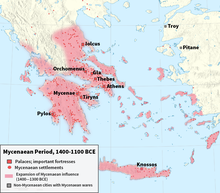Gresyang Myceneo
 | |
| Alternative names | Kabihasnang Mycenaeo |
|---|---|
| Geographical range | Pangunahing lupain ng Gresya, mga kapuluan sa Dagat Egeoat Kanluraning Anatolia |
| Period | Panahong Bronze |
| Dates | c. 1750 BE – c. 1050 BCE |
| Type site | Mycenae |
| Major sites | Pylos, Tiryns, Midea, Orchomenos, Iolcos |
| Characteristics |
|
| Preceded by | Kabihasnang Minoan, Kulturang Korakou, Kulturang Tiryns |
| Followed by | Panahong Madilim na Griyeg |
Ang Gresyang Myceneo o Kabihasnang Myceneo ang huling panahon ng Panahong Bronse ng Sinaunang Gresya na sumasakop sa panahong mula 1750 hanggang 1050 BCE.[1] Ito ay kumakatawan sa isang unang lubos na maunlad at natatanging Kabihasnang Griyego sa panunahing lupaing Gresya na may mga estado malapalasyo, organisasyong urbano, mga gawa ng sining at sistema ng pagsulat.[2][3] Ang mga Myceneo ay mga Griyegong he Mycenaeans were autochthonous na malamang na lumitaw sa kanilang pakikipag-ugnayan sa Kabihasnang Minoan at ibang mga kultura sa Dagat Mediterraneo at umunlad sa isang mas sopistikadong kulturang sosyopolitikal.[4] Ang pinakatanyag na lugar ng kabihasnang ito ang Mycenae kung saan nito nakuha ang pangalan nito. Ang ilang mga sentro ng kapangyarihang ng Kabihasnang Mycneo ay kinabibialangan ng Pylos, Tiryns, Midea sa Peloponnese, Orchomenos, Thebes, Athens sa Sentral na Gresya at Iolcos sa Thessaly. Ang Mycenaeo at naimpluwensiyahan ng Myceneo ay lumitaw rin sa Epirus,[5][6] Macedonia,[7][8] sa mga kapuluan ng Dagat Egeo,[9] sa timog-kanlurag baybayin ng Asya Menor, sa Levant[9][10] Cyprus,[11] at Italya.[12]
Ipinakilala ng mga Griyegong Myceneo ang mga ilang mga bagong idea sa larangan ng inhinyerya, arkitektura, imprastrakturang militar. Ang kalakalan sa mga lugar sa Mediterraneo ay mahalaga sa ekonomiyang Mycneo. Ang kanilang iskriptong syllabiko na Linear B ay nagbibigay rekord ng Indo-Europeong wikang Griyego at relihiyong Myceneo na kinabibilangan ng ilang mga Diyos] na matatagpuan sa Labindalawang Olimpiyano ng Mitolohiyang Griyego. Sa lipunang Myceneo, ito ay pinamumunuan ng hari na tinatawag na wanax.
Mga sanggunian
[baguhin | baguhin ang wikitext]- ↑ Knodell 2021, Table 1, pp. 7, 65.
- ↑ Lazaridis, Iosif et al. "Genetic origins of the Minoans and Mycenaeans". Nature, 2017 (Supplementary Information, "The Mycenaeans", pp. 2–3).
- ↑ Fields 2004, pp. 10–11.
- ↑ "Mycenaean Civilization". World History Encyclopedia (sa wikang Ingles). Nakuha noong 2021-07-29.
((cite web)): CS1 maint: date auto-translated (link) - ↑ Hammond 1976, p. 139: "Moreover, in this area a small tholos-tomb with Mycenaean pottery of III B style and a Mycenaean acropolis have been reported at Kiperi near Parga, and another Mycenaean acropolis lay above the Oracle of the Dead on the hill called Xylokastro."
- ↑ Tandy 2001, p. xii (Fig. 1); p. 2: "The strongest evidence for Mycenaean presence in Epirus is found in the coastal zone of the lower Acheron River, which in antiquity emptied into a bay on the Ionian coast known from ancient sources as Glykys Limin (Figure 2-A)."
- ↑ Borza 1992, p. 64: "The existence of a Late Bronze Age Mycenaean settlement in the Petra not only confirms its importance as a route from an early period, but also extends the limits of Mycenaean settlement to the Macedonian frontier."
- ↑ Aegeo-Balkan Prehistory – Mycenaean Sites
- ↑ 9.0 9.1 Castleden 2005, p. 192.
- ↑ van Wijngaarden 2002, Part II: The Levant, pp. 31–124; Bietak & Czerny 2007, Sigrid Deger-Jalkotzy, "Mycenaeans and Philistines in the Levant", pp. 501–629.
- ↑ van Wijngaarden 2002, Part III: Cyprus, pp. 125–202.
- ↑ Peruzzi 1980; van Wijngaarden 2002, Part IV: The Central Mediterranean, pp. 203–260.
Text is available under the CC BY-SA 4.0 license; additional terms may apply.
Images, videos and audio are available under their respective licenses.

